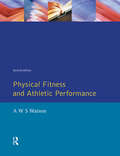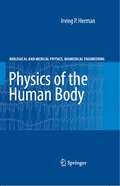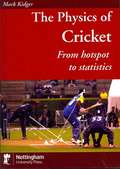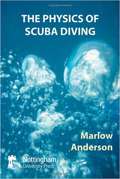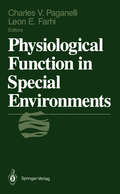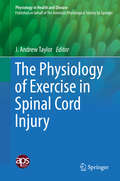- Table View
- List View
Physical Fitness and Athletic Performance: A Guide for Students, Athletes and Coaches
by A.W.S. WatsonSports Science has increasingly developed both as an area of research and as a university subject. This book gives an authoritative account of the biological basis of athletic performance and training, based on an analysis of scientific and medical research in the area. The findings are presented in such a way that anyone involved in training for high-level sport will find the information accessible and of interest.
Physical Fitness and Athletic Performance: A Guide for Students, Athletes and Coaches
by A.W.S. WatsonSports Science has increasingly developed both as an area of research and as a university subject. This book gives an authoritative account of the biological basis of athletic performance and training, based on an analysis of scientific and medical research in the area. The findings are presented in such a way that anyone involved in training for high-level sport will find the information accessible and of interest.
Physical Fitness Laboratories on a Budget
by Terry J. Housh Joel T. Cramer Joseph P. Weir Travis W. Beck Glen O. JohnsonThis lab manual is designed to benefit those colleges and universities that offer courses with lab components in physical fitness, exercise physiology, and healthy lifestyles but do not have the facilities and/or budget to allow students to train in high-tech laboratory settings. This long-overdue book-essential for sports and exercise science departments on a budget-provides meaningful lab experiences that don't require sophisticated and expensive equipment. The labs were written and designed to be self-administered or administered to others. Readers will find the book an essential resource for any career involving physical fitness and performance testing. This book's clear and concise layout makes it an ideal tool both for learning and for practical application in professional settings. The book includes 31 labs divided into eight units: Introductory labs Aerobic fitness Fatigue thresholds Muscular strength Muscular endurance Muscular power Body composition and body build Flexibility Labs include these features: Background, Terms and Abbreviations, Equipment (and pricing), Procedures, Equations, Sample Calculations, Worksheets, Tables, Extension Activities, and References. The manual also includes a table of units and conversions, a list of equipment and vendors, a Glossary, and an Index.
Physical Fitness Laboratories on a Budget
by Terry J. Housh Joel T. Cramer Joseph P. Weir Travis W. Beck Glen O. JohnsonThis lab manual is designed to benefit those colleges and universities that offer courses with lab components in physical fitness, exercise physiology, and healthy lifestyles but do not have the facilities and/or budget to allow students to train in high-tech laboratory settings. This long-overdue book-essential for sports and exercise science departments on a budget-provides meaningful lab experiences that don't require sophisticated and expensive equipment. The labs were written and designed to be self-administered or administered to others. Readers will find the book an essential resource for any career involving physical fitness and performance testing. This book's clear and concise layout makes it an ideal tool both for learning and for practical application in professional settings. The book includes 31 labs divided into eight units: Introductory labs Aerobic fitness Fatigue thresholds Muscular strength Muscular endurance Muscular power Body composition and body build Flexibility Labs include these features: Background, Terms and Abbreviations, Equipment (and pricing), Procedures, Equations, Sample Calculations, Worksheets, Tables, Extension Activities, and References. The manual also includes a table of units and conversions, a list of equipment and vendors, a Glossary, and an Index.
Physical Intelligence: The Science of Thinking Without Thinking
by Scott Grafton'An instant classic' Michael S. Gazzaniga, author of The Consciousness InstinctWhat is it that stops us from walking into walls or off cliffs? How do you pick the right moment to cross a busy road Or decide if you can drive through a storm? What helps you discover a shortcut to a familiar route?The answer is PHYSICAL INTELLIGENCESometimes, you need to do it to know it. Your hands have to be on the steering wheel to learn the feel of slipping tyres. You need to be watching the traffic to judge the best moment to cross the road. Everything we do, from changing a lightbulb to navigating unknown terrain relies on physical intelligence, our oldest and most important form of cognition. Physical intelligence was the key development in human evolution; thinking evolved first and foremost so we could do things. It has been the key to our survival against all the odds for so long that it has become instinctive, and continues to underpin our every action, from the ordinary (walking down a street) to the extraordinary (winning a race) and beyond. Renowned neuroscientist, doctor and keen climber, Scott Grafton was fascinated to discover how physical intelligence's most important components were laid bare, away from civilisation. In this book he takes you on a journey to explore the hidden depths of this silent, ruthless intellect we all possess. Drawing on the latest scientific discoveries and research, experiences with patients, and Professor Grafton's own gripping stories of survival in the wilderness, Physical Intelligence explains the science behind our most overlooked ability and takes a fascinating and vital look at how we could and should use it better.
Physical Literacy: Throughout the Lifecourse (Routledge Studies in Physical Education and Youth Sport)
by Margaret WhiteheadWhat is physical literacy? What are the benefits of being physically literate? The term ‘physical literacy’ describes the motivation, confidence, physical competence, understanding and knowledge that individuals develop in order to maintain physical activity at an appropriate level throughout their life. Physical literacy encompasses far more than physical education in schools or structured sporting activities, offering instead a broader conception of physical activity, unrelated to ability. Through the use of particular pedagogies and the adoption of new modes of thinking, physical literacy promises more realistic models of physical competence and physical activity for a wider population, offering opportunities for everyone to become active and motivated participants. This is the first book to fully explore the meaning and significance of this important and emerging concept, and also the first book to apply the concept to physical activity across the lifecourse, from infancy to old age. Physical Literacy – explaining the philosophical rationale behind the concept and also including contributions from leading thinkers, educationalists and practitioners – is essential reading for all students and professionals working in physical education, all areas of sport and exercise, and health.
Physical Literacy: Throughout the Lifecourse (Routledge Studies in Physical Education and Youth Sport)
by Margaret WhiteheadWhat is physical literacy? What are the benefits of being physically literate? The term ‘physical literacy’ describes the motivation, confidence, physical competence, understanding and knowledge that individuals develop in order to maintain physical activity at an appropriate level throughout their life. Physical literacy encompasses far more than physical education in schools or structured sporting activities, offering instead a broader conception of physical activity, unrelated to ability. Through the use of particular pedagogies and the adoption of new modes of thinking, physical literacy promises more realistic models of physical competence and physical activity for a wider population, offering opportunities for everyone to become active and motivated participants. This is the first book to fully explore the meaning and significance of this important and emerging concept, and also the first book to apply the concept to physical activity across the lifecourse, from infancy to old age. Physical Literacy – explaining the philosophical rationale behind the concept and also including contributions from leading thinkers, educationalists and practitioners – is essential reading for all students and professionals working in physical education, all areas of sport and exercise, and health.
Physical Literacy across the World (Routledge Studies in Physical Education and Youth Sport)
by Margaret WhiteheadPhysical Literacy across the World records the progress of the concept of physical literacy over the last decade. It examines developments, issues and controversies in physical literacy studies, and looks at how the concept has been implemented around the world. Contributions from practitioners and researchers across the world tell unique stories of the way physical literacy is changing perceptions of physical activity through research and the generation of scholarly writing, the creation of new national and local policies, and the development of partnerships with a range of professions. The book argues that physical literacy has value beyond formal education, such as in occupational and recreational settings, as well as for early years children and older people, and shows how life story methods can explain our physical literacy journeys. At root, it sets out a case for the significance and value of physical literacy as making a notable contribution to human flourishing. This is important reading for anyone with an interest in physical activity, health and well-being, sport studies, physical education, or the philosophy related to physical activity.
Physical Literacy across the World (Routledge Studies in Physical Education and Youth Sport)
by Margaret WhiteheadPhysical Literacy across the World records the progress of the concept of physical literacy over the last decade. It examines developments, issues and controversies in physical literacy studies, and looks at how the concept has been implemented around the world. Contributions from practitioners and researchers across the world tell unique stories of the way physical literacy is changing perceptions of physical activity through research and the generation of scholarly writing, the creation of new national and local policies, and the development of partnerships with a range of professions. The book argues that physical literacy has value beyond formal education, such as in occupational and recreational settings, as well as for early years children and older people, and shows how life story methods can explain our physical literacy journeys. At root, it sets out a case for the significance and value of physical literacy as making a notable contribution to human flourishing. This is important reading for anyone with an interest in physical activity, health and well-being, sport studies, physical education, or the philosophy related to physical activity.
Physical Principles of Electro-Mechano-Biology: Multiphysics and Supramolecular Approaches (Studies in Mechanobiology, Tissue Engineering and Biomaterials #25)
by Christian BrosseauThis book covers the recently developed understanding of Electro-Mechano-Biology (EMB) in which the focus is primarily on the couplings between the electric and mechanical fields. The emphasis lies on the analytical and computational aspects of EMB at the cellular level. The book is divided into two parts. In the first part, the author starts by defining and discussing the relevant basic aspects of the electrical and mechanical properties of cell membranes. He provides an overview of some of the ways analytical modelling of cell membrane electrodeformation (ED) and electroporation (EP) appears in a variety of contexts as well as a contemporary account of recent developments in computational approaches that can feature in the theory initiative, particularly in its attempt to describe the cohort of activities currently underway. Intended to serve as an introductory text and aiming to facilitate the understanding of the field to non-experts, this part does not dwell on the set of topics, such as cellular mechanosensing and mechanotransduction, irreversible EP, and atomistic molecular dynamics modelling of membrane EP. The second (and larger) part of the book is devoted to a presentation of the necessary analytical and computational tools to illustrate the ideas behind EMB and illuminate physical insights. Brief notes on the history of EMB and its many applications describing the variety of ideas and approaches are also included. In this part, the background of the first principles and practical calculation methods are discussed to highlight aspects that cannot be found in a single volume.
Physical Rehabilitation of the Injured Athlete E-Book
by James R. Andrews Gary L. Harrelson Kevin E. WilkPhysical Rehabilitation of the Injured Athlete is a medical reference book that equips you to apply today’s hottest strategies in non-operative sports rehabilitation, so you can help your patients return to play as quickly and fully as possible.Send your players back to the field fast with the latest strategies in non-operative sports rehabilitation. Get balanced, dependable guidance on sports rehabilitation from a multidisciplinary author team that contributes perspectives from orthopaedics and sports medicine, athletic training, and physical therapy. Ensure effective treatment planning with a stronger emphasis on evidence-based practice. Master the latest with brand-new chapters on Developing Treatment Pathways, Biomechanical Implications in Shoulder and Knee Rehabilitation, Temporomandibular Rehabilitation, Thigh Rehabilitation, Gait Assessment, Functional Movement Assessment, and Plyometric Training Drills.
Physical Virology: From the State-of-the-Art Research to the Future of Applied Virology (Springer Series in Biophysics #24)
by Mauricio Comas-Garcia Sergio Rosales-MendozaThis book highlights key findings generated during the past years from the main disciplines that constitute Physical Virology, from theoretical physics and simulations to material sciences and vaccines development to structural biology. Each chapter is written by world-class scientists from these areas and is a comprehensive review of where this field stands, as well as the future of Physical Virology. The diversity in the formal training of these scientists results in solving common problems using very distinct approaches, which can produce surprising findings. The multi- and interdisciplinary nature of this field has created a remarkable community that aims at understanding how viruses work and how they can be used in material sciences, chemistry, and biomedicine. Furthermore, the development of Physical Virology has resulted in technological advances that have shaped other fields; for example, it would be impossible to think about the development of Cryo-EM to solve the structure of complex viruses with atomic resolution without the contribution of scientists that created the field of Physical Virology. In the past decade, there has been a great success in the generation of viral systems that can encapsulate drugs, non-viral genetic material, or nanoparticles, as well as in the chemical and genetical modification of virions. Without any doubt in the immediate future, some of these technologies will jump from the bench to the market, creating a revolution in translational and biomedical sciences. The book provides key perspectives for the field, derived from expert´s opinions.
Physician's Field Guide to Neuropsychology: Collaboration through Case Example
by Karen M. SandersThis unique volume teaches those in the medical fields about the scientific value of neuropsychology in assessing cognition, the 6th vital sign, as part of well integrated collaborative care. It offers physicians a comprehensive tour of the many dimensions neuropsychology can add to primary and specialized medical care across the lifespan. Noted experts examine cognitive ramifications of a wide range of medical, psychological, and neuropsychological conditions, among them brain tumors, stroke, epilepsy, pediatric and adult TBI, schizophrenia, and adult ADHD. The book’s generous selection of case examples demonstrates the benefits of cognitive assessment in building accurate diagnoses, better understanding of patient needs, and more appropriate treatment and management strategies, as well as other neuropsychologist roles in consulting, referral, and forensic areas. In addition, tables, callout boxes, review questions, and other features are included throughout the text for ease in comprehension and retention. A sampling of the coverage:· The value of neuropsychological evaluation in medical practice. · A model of collaboration between primary care and neuropsychology. · Neuropsychological assessment of extremely preterm children. · Alzheimer’s Disease and overview of dementia. · Deep brain stimulation for Parkinson’s Disease. · Neuropsychology in the 21st century: the rise of multicultural assessment. · Neuropsychological interventions for individuals with brain injury. The Physician’s Field Guide to Neuropsychology is both a rigorous and an accessible reference for clinicians in diverse disciplines including general practice, family medicine, neuropsychology, pediatrics, gerontology, and sports medicine.
The Physics of Basketball
by John J. FontanellaDrain three pointers, slam dunk easily, and sink that buzzer beater from half court with the help of simple science. Your coach, physicist John J. Fontanella, shows how you can improve your game if you take advice from Isaac Newton. As you read, relive some of the great moments in the game—this time with a scientist and diehard basketball fan as your color analyst. Find out why you ought to put spin on the ball. Get tips on how to improve your free throw and increase your percentage from the charity stripe. You’ll even learn how to shatter the backboard, if that’s something you’ve always dreamed of doing. With photographs and simple high school formulas, physics professor Fontanella—who played in college against Pittsburgh and Syracuse—reveals the key pieces of physics that underscore basketball. He covers almost every aspect of the game, weaving in stories from games he’s played and games he’s seen, and tales from basketball history and folklore. Physics comes alive as you see how Kobe Bryant, Wilt "the Stilt" Chamberlain, Michael Jordan, Becky Hammon, and J. J. Reddick do naturally the things that Isaac Newton says they should.
The Physics of Krav Maga
by John Eric GoffKrav Maga ("contact combat" in Hebrew) is a hard-hitting and efficient form of self-defense that was popularized by Israeli soldiers. Stressing practical, real-world fighting and a philosophy of self-defense, its popularity has grown worldwide over the past few decades. In The Physics of Krav Maga, John Eric Goff, a physicist, best-selling author, and martial arts practitioner, explains the science behind dozens of Krav Maga moves, from headlocks to hammer fists. Focusing on Warrior Krav Maga, a fighting style that combines the key elements of Krav Maga with kickboxing, wrestling, karate, and other fighting specialties, this equation-free, conceptual introduction is aimed at martial arts practitioners interested in refining their fighting technique and all fans of the fascinating moment when sports meet science.With step-by-step descriptions and detailed photos of each critical motion, Goff takes a scientific look at everything from punch speed to power output and reaction time. Armed with this book, readers will understand the physics behind each move. They will also learn how to• enhance their level of physical fitness• disrupt an opponent's balance—while keeping theirs• make use of leverage to defeat a larger, stronger attacker• become faster and more powerful• inflict pain up close• use weapons—and "weapons of opportunity"• and much more!Anyone interested in martial arts, in how physics applies to sports and combat, and in how a physicist wins a fight will love The Physics of Krav Maga.
The Physics of Krav Maga
by John Eric GoffKrav Maga ("contact combat" in Hebrew) is a hard-hitting and efficient form of self-defense that was popularized by Israeli soldiers. Stressing practical, real-world fighting and a philosophy of self-defense, its popularity has grown worldwide over the past few decades. In The Physics of Krav Maga, John Eric Goff, a physicist, best-selling author, and martial arts practitioner, explains the science behind dozens of Krav Maga moves, from headlocks to hammer fists. Focusing on Warrior Krav Maga, a fighting style that combines the key elements of Krav Maga with kickboxing, wrestling, karate, and other fighting specialties, this equation-free, conceptual introduction is aimed at martial arts practitioners interested in refining their fighting technique and all fans of the fascinating moment when sports meet science.With step-by-step descriptions and detailed photos of each critical motion, Goff takes a scientific look at everything from punch speed to power output and reaction time. Armed with this book, readers will understand the physics behind each move. They will also learn how to• enhance their level of physical fitness• disrupt an opponent's balance—while keeping theirs• make use of leverage to defeat a larger, stronger attacker• become faster and more powerful• inflict pain up close• use weapons—and "weapons of opportunity"• and much more!Anyone interested in martial arts, in how physics applies to sports and combat, and in how a physicist wins a fight will love The Physics of Krav Maga.
Physics of the Human Body (Biological and Medical Physics, Biomedical Engineering)
by Irving HermanThis book comprehensively addresses the physical and engineering aspects of human physiology by using and building on first-year college physics and mathematics. It is the most comprehensive book on the physics of the human body, and the only book also providing theoretical background. The book is geared to undergraduates interested in physics, medical applications of physics, quantitative physiology, medicine, and biomedical engineering.
Physics of the Human Body (Biological and Medical Physics, Biomedical Engineering)
by Irving P. HermanThis book comprehensively addresses the physics and engineering aspects of human physiology by using and building on first-year college physics and mathematics. Topics include the mechanics of the static body and the body in motion, the mechanical properties of the body, muscles in the body, the energetics of body metabolism, fluid flow in the cardiovascular and respiratory systems, the acoustics of sound waves in speaking and hearing, vision and the optics of the eye, the electrical properties of the body, and the basic engineering principles of feedback and control in regulating all aspects of function. The goal of this text is to clearly explain the physics issues concerning the human body, in part by developing and then using simple and subsequently more refined models of the macrophysics of the human body. Many chapters include a brief review of the underlying physics. There are problems at the end of each chapter; solutions to selected problems are also provided. This second edition enhances the treatments of the physics of motion, sports, and diseases and disorders, and integrates discussions of these topics as they appear throughout the book. Also, it briefly addresses physical measurements of and in the body, and offers a broader selection of problems, which, as in the first edition, are geared to a range of student levels. This text is geared to undergraduates interested in physics, medical applications of physics, quantitative physiology, medicine, and biomedical engineering.
Physik des Segelns: Wie Segeln wirklich funktioniert
by Wolfgang PüschlEine Einführung in die physikalischen Grundlagen des Segelsports für die an Naturwissenschaften interessierten Segler, die schon immer wissen wollten, wie Segeln tatsächlich funktioniert. »Physik des Segelns« führt zunächst in die einfachen Grundsätze und Bedingungen des Segelns ein, wie beispielsweise das Kräftegleichgewicht während der Fahrt. Anschließend wird aus den Eigenschaften von Luft und Wasser und den dynamischen Grundgleichungen das Entstehen dieser Kräfte dargelegt. Das Buch räumt mit verbreiteten falschen Vorstellungen auf und schreitet systematisch von der Betrachtung zweidimensionaler Phänomene zu dreidimensionalen Phänomenen voran. Von Erscheinungen innerhalb der Medien Luft und Wasser geht es weiter zu den Erscheinungen an ihrer Grenzfl äche, den Schwerewellen des Wassers und dem damit verbundenen Widerstand. Mit der Kenntnis aller Beiträge zur Vortriebsleistung wird erläutert, wie sie aufeinander abgestimmt werden müssen, um ein optimales Segeltempo zu erreichen. Abschließend werden zeitlich veränderliche Phänomene wie Manöver und das Arbeiten des Bootes im Seegang betrachtet, und die Materialfestigkeit von Takelage und Rumpf diskutiert.
Physik des Segelns: Wie Segeln wirklich funktioniert
by Wolfgang PüschlEine Einführung in die physikalischen Grundlagen des Segelsports für die an Naturwissenschaften interessierten Segler, die schon immer wissen wollten, wie Segeln tatsächlich funktioniert. »Physik des Segelns« führt zunächst in die einfachen Grundsätze und Bedingungen des Segelns ein, wie beispielsweise das Kräftegleichgewicht während der Fahrt. Anschließend wird aus den Eigenschaften von Luft und Wasser und den dynamischen Grundgleichungen das Entstehen dieser Kräfte dargelegt. Das Buch räumt mit verbreiteten falschen Vorstellungen auf und schreitet systematisch von der Betrachtung zweidimensionaler Phänomene zu dreidimensionalen Phänomenen voran. Von Erscheinungen innerhalb der Medien Luft und Wasser geht es weiter zu den Erscheinungen an ihrer Grenzfl äche, den Schwerewellen des Wassers und dem damit verbundenen Widerstand. Mit der Kenntnis aller Beiträge zur Vortriebsleistung wird erläutert, wie sie aufeinander abgestimmt werden müssen, um ein optimales Segeltempo zu erreichen. Abschließend werden zeitlich veränderliche Phänomene wie Manöver und das Arbeiten des Bootes im Seegang betrachtet, und die Materialfestigkeit von Takelage und Rumpf diskutiert.
Physikalische Medizin
by A. LangeSystematisch, detailgenau und übersichtliche führt das Buch in die wichtigsten Methoden der physikalischen Medizin ein.- Durchführung, Wirkmechanismen und Anwendungsmöglichkeiten- Therapie-Pläne für den Einsatz physikalischer Therapie bei besonders häufigen Indikationen- Konkrete Therapie-Empfehlungen, die Sie direkt in der Praxis umsetzen können- Didaktisch klare und einheitliche Struktur zum raschen Nachschlagen- Ansprechendes zweifarbiges Layout mit anschaulichen Farb-ZeichnungenAls Lehrbuch und Nachschlagewerk konzipiert, bietet Ihnen das Buch die sichere Basis sowohl für den praktischen Einsatz physikalischer Methoden als auch für Ihre qualifizierte Fort- und Weiterbildung.
Physiof Cricket: From Hotspot to Statistics
by Mark KidgerSpin, swing, seam, irregular bounce, using the pace of the ball, Hawkeye - cricket is littered with technical terms and, increasingly, with technology. The Pakistani bowlers who, in the 1980s, discovered that under certain circumstances they could get the ball to swing through the air in the opposite sense to the way that all logic suggested (so-called “reverse swing”) were actually applying fluid dynamiand the modification of airflow over a surface in a quite brilliant way, although probably ignorant of the hydrodynamical principals involved.
Physiof Scuba Diving
by Marlow AndersonThis book provides a fun introduction to the mathematiand physineeded to really understand scuba diving; it was written by an enthusiastic scuba diver, who is also a mathematician. The book is written for the lay person, and assumes only a willingness to express basic scientific relationships using mathematical equations. The book describes all of the basiregarding pressure, depth and density, covered more completely than in the typical open water diving course. But in addition, it looks at the mathematical background for dive tables and dive computers, tools divers use to avoid getting decompression sickness.The book explains the basic Haldane theory of nitrogen on-gassing and off-gassing, in more depth than is found in the popular literature. The book would appeal to divers interested in a bit more background that is available in the popular literature, and to people interested in how basic science and mathematihas a large impact on the sport of scuba diving. The book has been used as a textbook for a popular introduction to mathematical thinking.
Physiological Function in Special Environments
by Charles V. Paganelli Leon E. FarhiThe numerous ways in which man and animals are affected by their physical environment, and the inborn and adaptive responses to change in the "milieu exterieur" have fascinated curious minds since the earliest days of recorded history. Development of the scientific method with its emphasis on evidence obtained through experimentation-perhaps best illustrated in this field by Paul Bert's encyclopedic work-allowed several generations of our predecessors to establish firmly some facts and reject erroneous beliefs, but it was only during the early 1940s that environmental physiology put on its seven-league boots. In 1941, a young physiologist named Hermann Rahn was recruited by Wallace O. Fenn, then Chairman of the Department of Physiology at the University of Rochester, who was engaged in a study of the effects of altitude on human performance. The years that followed witnessed some of Hermann Rahn's early achievements not only in the area of altitude, but in other aspects of environmental physiology as well. In particular, he participated in the definitive studies of human adaptive mechanisms in arid climates which formed the basis of Edward Adolph's classic "Physi ology of Man in the Desert" (Wiley/Interscience, NY 1947). During those golden years, environmental physiology flourished, and important dis coveries were reported in a seemingly endless stream from many labora tories.
The Physiology of Exercise in Spinal Cord Injury (Physiology in Health and Disease)
by J. Andrew TaylorEvery year, around the world, between 250,000 and 500,000 people suffer a spinal cord injury (SCI). Those with an SCI are two to five times more likely to die prematurely than people without a spinal cord injury, with worse survival rates in low- and middle-income countries. Dynamic aerobic requires integrated physiologic responses across the musculoskeletal, cardiovascular, autonomic, pulmonary, thermoregulatory, and immunologic systems. Moreover, regular aerobic exercise beneficially impacts these same systems, reducing the risk for a range of diseases and maladies. This book will present comprehensive information on the unique physiologic effects of SCI and the potential role of exercise in treating and mitigating these effects. In addition, it will incorporate work from scientists across a number of disciplines and have contributors at multiple levels of investigation and across physiologic systems. Furthermore, SCI can be considered an accelerated form of aging due to the severely restricted physical inactivity imposed, usually at an early age. Therefore, the information presented may have a broader importance to the physiology of aging as it relates to inactivity. Lastly, the need for certain levels of regular aerobic exercise to engender adaptations beneficial to health is not altered by the burden of an SCI. Indeed, the amounts of exercise necessary may be even greater than the able-bodied due to ‘passive’ ambulation. This book will also address the potential health benefits for those with an SCI that can be realized if a sufficient exercise stimulus is provided.
